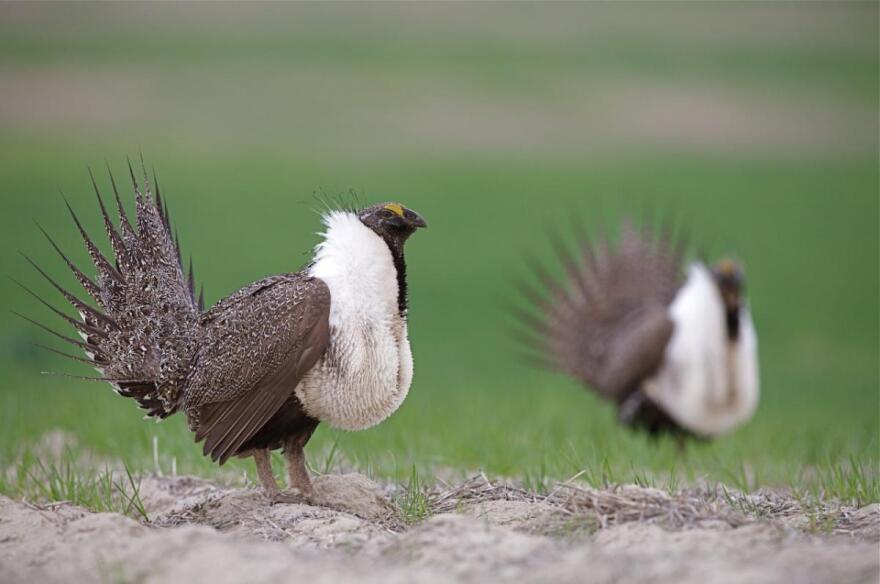Almost everything about June was terrible, but one group of people had a few reasons to cheer: Nevada conservationists. From spring-filled basins north of Las Vegas to grassy plains bordering Idaho, a trio of actions blocked sensitive habitat from development — at least for now. As any longtime activist will tell you, the battle for control of public lands in the West is a forever war. Here’s the latest from the local front, with caveats:
THE GREATER SAGE GROUSE
Parties involved: State and federal agencies, mining companies, developers, environmentalists, ranchers, you name it. If they’ve got an interest in the bulbous-chested game bird’s territory, they’re
following this news.
Action: The Nevada Department of Conservation and Natural Resources said on June 4 that a landowner and mining company had struck the first deal under a state ecosystem-mitigation program (the first not between two entities belonging to the same owner, that is). The program, called the Conservation Credit System, or CCS, allowed Crawford Cattle to put private land inhabited by sage grouse on a market where developers can, in essence, “buy” its protection. Coeur Mining took Crawford up on the offer, agreeing to preserve 3,000 acres for 30 years. In exchange, the miner gets credits to develop sage grouse habitat elsewhere. The state came up with the CCS as part of the sweeping 2015 sage grouse protection agreement spearheaded by the Obama administration. Although the Trump administration has rolled back much of that plan, Nevada kept some of its own protections in place, including the CCS.
Buuuuut … : Conservationists point out that the plan still allows habitat for the sage grouse, whose numbers are declining, to be destroyed.
Big picture: It’s rare for government, industry, and private owners to compromise on the use of land in which they have competing interests. State wildlife managers say it will be a decade or more before they know if this plan is working. In the meantime, the sage grouse’s habitat could become riddled with mines, oil wells, and solar plants.
DESERT NATIONAL WILDLIFE REFUGE
Parties involved: The U.S. Air Force versus a diverse collection of environmentalists, recreationists, and tribes, with the Fish and Wildlife Service caught in the middle
Decision: Conservationists let out a collective cheer on June 11, when the Senate Armed Services Committee released its markup of the National Defense Authorization Act. The bill contained a reference to the Nevada Test and Training Range that implied management of the Desert National Wildlife Refuge would remain status quo, rather than some of it being given to the Air Force for bombing maneuvers, as the military wanted. The celebration was short-lived, however. On July 1, the House Armed Services committee approved its own version of the NDAA and — contrary to the Senate’s — it turns control of some 850,000 acres of the wildlife refuge over to the military for training exercises.
Buuuuut … : Both versions of the NDAA have to go to their full respective chambers for a floor vote. Conservationists are urging opponents to call their congressional representatives, all of whom have, at some point, said they favor keeping the refuge mostly intact.
Big picture: It’s hard to imagine Congress going against a state’s entire delegation on a decision about land use in their state. Then again, this is 2020.
COYOTE SPRINGS
Parties involved: Numerous developers, environmentalists, tribes, water utilities, and … the Mormon Church? (Yep.) Some of the more notable names include the SNWA and Coyote Springs Investment, which has plans to build a golf community about an hour north of Las Vegas.
Action: On June 15, the Nevada State Engineer’s office issued Order 1309, the result of nearly two decades of back and forth between the agency; various public and private entities with water rights and/or applications in a 50,000-square-mile chunk of southeastern Nevada; and the scientists they all hired to study the network of aquifers, springs, and streams in question. The arcane 65-page order summarizes the stages leading to the engineer’s decision to combine disparate areas into one hydrographic basin, the Lower White River Flow System, and cap pumping of water out of that system at 8,000 square feet per year. It cites senior water rights and protection of the endangered Moapa Dace fish’s territory as main factors in the decision. The upshot is that some planned development, including the Coyote Springs community, won’t be able to go forward unless it uses water from somewhere other than the Lower White River Flow System.
Buuuuut … : Interested parties have 30 days to challenge the order. SNWA has already filed a lawsuit, and it's unlikely to be the last to do so.
Big picture: As State Water Resources Division Deputy Administrator Micheline Fairbank put it, “Order 1309 is just phase one of a much larger process.” Hopefully that process will determine how to sustainably manage a small amount water with big claims on it — while satisfying laws that, at times, put those claims in conflict.








